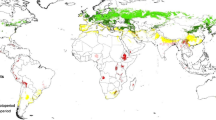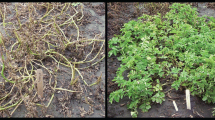Summary
Potatoes account for about half of the world's annual output of all roots and tubers, and since the early 1960s, the increase in area planted in developing countries has been higher than for any other major food crop. Annual world production currently totals 274 million tons on 18 million hectares, with China and India accounting for 22 percent of this total. In less than a generation, most of the world's potatoes will be harvested in Asia. Africa, or Latin America, where the potato is becoming an increasingly important source of food and its cultivation provides rural employment and income for the growing population. The rapid emergence of processing facilities for the fast food industry, and the indirect influence of improved rice and wheat irrigation systems have also contributed to the expansion of potato production in Asia. The demand is strongest for processing quality potatoes that supply the fast food chains in large urban concentrations where processed potato products fetch top prices. Such increasing demand is putting strong pressure on national and international breeding institutions to produce high quality processing varieties well adapted to the wide array of agro-ecological conditions, in South East Asia in particular. The lack of adequate seed systems in this region is the single most important impediment to the expansion of the cultivation of the crop. Unfavourable agro-ecological conditions interfere with the production of high quality seed in most Asian potato growing areas, and the availability of high quality seed of the right quantity at the right time remains the most consequential bottleneck to efficient potato production. The seed issue is also the principal problem of potato cultivation in the traditional potato growing areas of Central and Eastern Europe. A review of “the development of integrated systems for large scale propagation of elite plants using in vitro techniques” with specific focus on “potato seed production by tissue culture” is therefore very timely. It provides a platform for analysis and discussion of solutions for some of the most common seed problems facing the potato industry in many parts of the word. All efforts to improve the potato crop and to solve the associated seed problems begin with the right choice and use of the available genetic resources. Resistance to certain pests and diseases has a direct bearing on the success of a seed program. Multiple virus resistance, in particular, would ensure a halt to seed degeneration caused by an accumulation of viruses and thus greatly prolong the ability of seed producers and ware potato growing farmers to grow their crops at great economic benefit. This paper will therefore deal with the current status of the World Potato Collection held in trust by the International Potato Center (CIP) in Peru by presenting up-to-date information on its classification, phytosanitary status and availability of the genetic material and its evaluation data to the breeders worldwide.
Similar content being viewed by others
References
Bamberg, J.B., Z. Huamin & R. Hoekstra, 1995. International cooperation in potato germplasm. In: R.R. Duncan, D.M. Kral & M.K. Viney (Eds), International Germplasm Transfer: Past and Present. Crop Science Society of America, special publication No. 23, pp. 177–182.
Brown, A.H.D. 1989a. The case for core collections. In: A.H.D. Brown, O.H. Frankel, R.D. Marshall & J.T. Williams (Eds), The use of plant genetic resources. Cambridge University Press, Cambridge, UK, pp. 13–156.
Brown, A.H.D., 1989b. Core collections: A practical approach to genetic resources management.Genome 31: 818–824.
Brown, A.H.D., 1992. The core collections at the crossroads. Paper presented at the International Workshop on Core Collections of Plant Germplasm, August 1992, Brasilia, Brazil.
Douches, D.S. & K. Ludlam, 1991. Electrophoretic characterization of North American potato cultivars.American Potato Journal 68: 767–780.
Frankel, O.H. & A.H.D. Brown, 1984. Current plant genetic resources — a critical appraisal. In: Genetics: New Frontiers. Vol IV. Oxford & IBH Publ. Co. New Delhi, India, pp. 1–11.
Hawkes, J.G., 1990. The potato. Evolution, biodiversity and genetic resources, Belhaven Press, London, 259 p.
Hermsen, J.G.Th. & L.M. Taylor, 1979. Successful hybridisation of non-tuberousS. etuberosum Lind. and tuber-bearingS. pinnatisectum Dun.Euphytica 28: 1–7.
Huamán, Z., 1986. Conservation of potato genetic resources at CIP.CIP Circular 14(2): 1–7.
Huamán, Z., 1994. Ex situ conservation of potato genetic resources at CIP.CIP Circular 20(3): 1–7.
Huamán, Z., A. Golmirzaie & W. Amoros, 1997. The Potato. In: Dominic Fuccillo, Linda Sears & Paul Stapleton (Eds), Biodiversity in Trust: Convervation and Use of Plant Genetic Resources in CGIAR Centres. Cambridge University Press, Cambridge, UK, pp. 21–28.
Huamán, Z. & P. Schmiediche, 1991. The importance of ex situ conservation of germplasm: A Case study.Diversity 7(1&2): 68–69.
Lizárraga R., A. Panta, U. Jayasinghe & J. Dodds, 1991. Cultivo de tejidos para la eliminación de patógenos. Guia de Investigación CIP 3, Centro Internacional de la Papa (CIP), Lima, Peru, 21p.
Mendoza, H.A. & P. Jatala, 1985. Breeding potatoes for resistance to root knot nematodesMeloidogyne spp. In: Sasser & Carter (Eds), An advanced treatise on Meloidogyne. North Carolina State University, USA, pp. 217–224.
Mendoza, H.A., 1994. Development of potatoes with multiple resistance to biotic and abiotic stresses: The International Potato Center Approach. In: G.W. Zehnder, M.L. Powelson, R.K. Jansson & K.V. Raman (Eds), Advances in Potato Pest, Biology and Management. APS Press, 655 pp.
Ochoa, C., 1990. The potatoes of South America: Bolivia. Cambridge University Press, Cambridge, Great Britain, 512 pp.
Ross, H., 1986. Potato breeding: Problems and perspectives. In: W. Hom & G. Röbbelen (Eds), Journal of Plant Breeding Supplement 13, pp. 132.
Watanabe, Y. & S.J. Peloquin, 1989. Occurrence of 2n pollen andps gene frequencies in cultivated groups and their related wild species in tuber-bearingSolanums.Theoretical and Applied Genetics 79: 329–336.
Author information
Authors and Affiliations
Rights and permissions
About this article
Cite this article
Huamán, Z., Schmiediche, P. The potato genetic resources held in trust by the International Potato Center (CIP) in Peru. Potato Res 42, 413–426 (1999). https://doi.org/10.1007/BF02358158
Issue Date:
DOI: https://doi.org/10.1007/BF02358158




